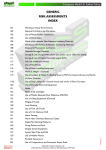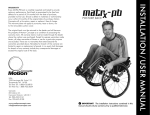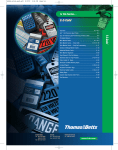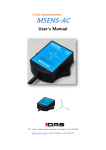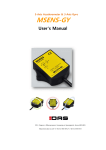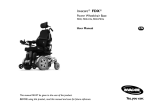Download User Manual For V-trak
Transcript
V-Trak Backrest Systems USER MANUAL AND INSTALLATION INSTRUCTIONS FOR ALL V-Trak BACKRESTS Version 1.5.3 - 13/07/2007 13/07/2007 User manual, installation and adjustment instructions for V-Trak Backrest Systems Contents: Safety & maintenance Page Safety and transportation 3 Overview 4 Removal and replacement 5 Warranty 6 Maintenance and cleaning 6 Installation Installing Mounting Blocks 7-9 Assembling the Central Mount and Arms 10 Installing the Central Mounting Assembly 11 Assembling backrest segments 12 Installing the backrest 13 Backrest shaping adjustments Adjusting the backrest shape – Comfort Adjusting the backrest shape – Axxis 14 15-16 Adjusting the backrest shape – Axxis segmented backrests 17 Positional adjustments Height 17 Backrest angle 18 Seat depth 18-19 Asymmetrical positioning 19 Backrest loading High body mass, high tone, tilt-in-space & recline 20-21 Loading guidelines 22-23 Tissue viability and pressure sores 23 Security Safety checklist 24-25 Applications Selecting a system 26-27 Installation summary 28 2 Safety and transportation 1. The equipment described in this manual should be installed and adjusted by suitably qualified professionals such as Occupational Therapists or Rehabilitation Engineers. 2. This Guide is intended for the user of the equipment and all others involved in its application and use. 3. Like all mechanical equipment, misuse or incorrect application may cause injury to the user and/or others. 4. Like many modular systems, it is possible to construct a configuration which exceeds the design limits of the system. Also, its installation may affect the stability of the host wheelchair. It is the responsibility of specifiers and issuers of the equipment to carry out a risk assessment and to advise on the safe use and deployment of the equipment. 5. High tone/body mass and tall users may require the use of 4 point attachment hardware and/or stabilizing accessories. Refer to pages 21-23. 6. Advanced orientation facilities such as recline and tilt-in-space will increase the loading of the backrest and accessories. This may require additional hardware and strengthening accessories available from your distributor. Refer to pages 21-23 7. The V-Trak system has been Crash Tested to the ANSI RESNA standards for Wheelchairs Ref: WC19 and WC20 and is suitable for use as Seating in Transportation. When used as seating in transportation, an adequate head support should be used for such journeys. A wide range of V-Trak removable headrests is available from your distributor. 9. Once a V-Trak backrest system has been installed and adjusted, follow the instructions on the Safety Checklist on pages 24-25 to ensure that the installation is properly and safely completed. 10. Complete the summary on Page 28 and leave with the appropriate person. 11. Further detailed information on the deployment, use and maintenance of V-Trak products is available from the following sources: • • • • Your local V-Trak distributor/dealer V-Trak Assessment Manual (also available online) V-Trak Help Manual (also available online) V-Trak websites – www.v-trak.com, www.php-usa.com Authorised distributor: Tel: _________________ Fax: Email: _________________ Web Site: _________________ 3 _________________ V-Trak System - overview Figure 1 Central Mount Backrest Locking Lever Wheelchair upright (Push Handle/Cane) Mounting Block Arms Backrest track The system consists of: ♦ Two Mounting Blocks that are fixed, one on each side, to the upright tubular sections (Push Handles/Canes) of the wheelchair. ♦ Each mounting block is connected, through a Locking Lever, to a horizontal Arm. ♦ The arms are joined by a Central Mount which is secured to the Backrest track. ♦ Backrests are available in a wide range of sizes and configurations and are compatible with an extensive range of V-Trak accessories and with third-party accessories. Axxis and Comfort backrest ranges are available in a range of popular sizes as complete boxed systems. These contain the backrest and all the necessary mounting hardware. They can be ordered using a single product code. Please refer to the Boxed Product Order Forms The Segmented range includes the full range of Axxis one-piece backrests, backrest segments and accessories. These are ordered by specifying the individual items which make up a whole backrest system. Please refer to the Axxis and Segmented Order Form for details of product sizes and ordering codes. 4 Backrest removal and replacement To remove or replace the backrest when folding the wheelchair for transportation, or to change between wheelchairs fitted with identical mounting blocks, observe the following procedures. Removing the Backrest ♦ Raise the Locking Lever at the end of each V-Trak Arm past the fully vertical position, to the Unlocked position as shown in the diagram. ♦ With a hand under the outer end of each V-Trak Arm, lift the system evenly upwards and clear of the Mounting Blocks. ♦ Fully remove the system from the wheelchair chassis. Unlocked Locking Lever Figure 2 Pin Locked Securing Nut Mounting Block Replacing the Backrest 1. Ensure both Locking Levers are in the Unlocked position. 2. With both hands under the outer ends of the V-Trak Arms, lower the system evenly into the Mounting Blocks on the wheelchair. 3. When the Pins are located in the holes in the Mounting Blocks, push down firmly. Ensure that the pins are fully located before pressing the Locking Levers downwards until fully horizontal, in the Locked position. The system is now firmly attached to the wheelchair. 4. Check the security of the backrest before sitting in the wheelchair. Note: It may be necessary to adjust the force required to lock and unlock the system to: 1. suit the strength and/or dexterity of the user 2. maximise the retention of the backrest. 5 Warranty Performance Health Products Ltd (PHP) fully guarantees the V-Trak range of products against faulty materials or workmanship for a period of 24 months from the date of invoice to the EndUser, subject to the following conditions: 1. 2. 3. 4. 5. 6. Goods must have been purchased from an authorised supplier/distributor In the event of a claim the supplier must notify PHP immediately Faulty goods must be retained by the supplier for inspection by PHP Defective products will be repaired or replaced free of charge at PHP’s option Products must be installed in accordance with the manufacturer’s instructions Products must be used for the purpose for which they were designed Limitations The warranty does not cover: ♦ ♦ ♦ ♦ Fair wear and tear. Abuse or inappropriate use. Unauthorised alterations or adjustments. Damage or deterioration due to failure to maintain the product as directed. Maintenance & cleaning When the installation is complete, remember to check that: 1. 2. 3. 4. All screws are fully tightened All washers and locking nuts are present All locking nuts are properly tightened without loosening the main screw That the removal and replacement of the Backrest is smooth and easy to operate It is important to check the above items periodically. The interval between inspections should reflect the nature and frequency of use. Washing instructions Standard covers are made from a foam-backed fabric and are not waterproof. Any spillage should be removed immediately with a moist cloth. Further cleaning may be carried out with a suitable upholstery spray cleaner (following the instructions). The cover may be machine washed; observe the instruction symbols below. Replacement covers are available. Waterproof covers are also available. These fit over the existing standard covers. Please refer to the V-Trak Product Catalogue for details. 6 Installing all Mounting Blocks except MB-UN (Netti & ETAC) Determine the most suitable position for the mounting blocks. Unless there are obstructions on the uprights or other limiting factors, the optimum location for the backrest pivot point will be at approximately as shown in Figure 3A.Typically this will be approximately 60% of the distance from the bottom to the top of the backrest track. Each case will be different according to the client’s body mass and likely behaviour. Every effort should be made to balance the likely rotational forces above and below the pivot point. Figure 3 3A 3B 3C The optimum balance point may not be practical due to obstructions on the wheelchair uprights or other reason. If installations such as Figure 3B or 3C are required, it may be necessary to use a secondary arm at the top for 3B or at the bottom for 3C. Sometimes, a four point attachment configuration may be required to accommodate any excessive forces. Refer to Pages 21-23 for further guidance. Installation instructions for standard mounting blocks: 1. Remove the canvas backrest from the wheelchair according to the manufacturer’s recommended procedures. 2. Remove the Mounting Blocks from their packing and dismantle 3. Using the 5mm Key wrench, remove the two screws Figure 4 (1) from the mounting block and withdraw the tightening wedges (2 and 3) and the pin block (4) 4. Install one Mounting Block at the optimum height for the backrest, ensuring the screw holes are to the outside of the wheelchair and accessible for final positioning. Repeat the process for the second mounting block on the opposite side but approximately 50mm lower than the first block. 5. Ideally the mounting blocks should be facing inward at an angle of approximately 45 degrees but they can be used in a parallel configuration to the front or rear of the wheelchair. If the tubes are not of round section the special blocks available cannot be rotated but they can be mounted to the front or rear of the uprights or in intermediate positions depending on the cane profile 6. Do not over tighten at this stage. Allow the mounting block to rotate under moderate pressure. Figure 4 2&3 1 4 7 Installing Universal Mounting Blocks, MB-R-UE & MB-R-US Contents: MB-R-UE - configured for Europe 2 x Clamp Bands for 22mm (7/8”) diameter wheelchair uprights 2 x Pin blocks 2 x Plain wedges 2 x Threaded wedges 4 x Clamping Screws Contents: MB-R-US – configured for USA 2 x Clamp Bands for 25mm (1”) diameter wheelchair uprights 2 x Pin blocks 2 x Plain wedges 2 x Threaded wedges 4 x Clamping Screws 2 x 25mm (1”) diameter Clamp Band for 25mm (1”) diameter wheelchair uprights 2 x Spacer Shell – use with 25mm (1”) Clamp Band on 3/4” (19/20mm) diameter uprights 2 x Thick Spacer Shells – use with 25mm (1”) Clamp Band on 3/4” (19/20mm) diameter uprights 2 x Thin Spacer Shells – use with 25mm (1”) Clamp Band on 7/8” (22mm) diameter uprights Instructions: 1. Remove the canvas backrest from the wheelchair according to the manufacturer’s recommended procedures. 2. Remove the Mounting Blocks from their packing and dismantle 3. Install as for standard mounting blocks but using additional Clamp Bands and/or spacers where necessary as indicated below. In most cases the pre-assembled mounting block will be suitable. Occasionally it may be necessary to use the additional Clamp Bands with, or without, the Spacer Shells, to suit different diameter uprights. Screws accessible Screws accessible Figure 6 Figure 5 Note: The Mounting Blocks are usually installed to the rear of the canes (Figure 5) but may also be mounted in front (Figure 6 ) of the uprights. In either case, always ensure the Clamping Screws are on the outside and therefore accessible for final adjustment and tightening. Observe the correct position for any spacers which must not be in contact with the tightening wedges. Figure 7 8 Installing Mounting Blocks MB-UN for Netti and Etac wheelchairs Mounting Block Contents: 2 x Clamp Bands for NETTI Mark I wheelchair uprights 2 x Clamp Bands for NETTI Mini wheelchair uprights 2 x Pin blocks 2 x Plain wedges 2 x Threaded wedges 4 x Screws 2 x Tube inserts (sleeves) for ETAC wheelchair uprights 2 x 25mm x 4mm high tensile socket countersunk screws 1 x 3mm Allen key Instructions - NETTI Mini (and new models): 1. Remove the canvas backrest from the wheelchair according to the manufacturer’s recommended procedures. 2. Remove the mounting blocks from their packing and dismantle 3. Install as for standard mounting blocks but for NETTI Mini mount the blocks in a parallel configuration to the front or rear of the uprights as shown in Figures 8 & 9 4. If V-Trak Thoracic Supports are to be fitted in the NETTI Mini, the forward position will normally be required. Figure 8 Figure 9 Screws Accessible Screws accessible Note: The Mounting Blocks may be installed to the front (Figure 8) or rear (Figure 9) of the uprights as shown. In either case always ensure the Clamping Screws are on the outside and therefore accessible for final adjustment and tightening. Instructions – ETAC Figure 10 Screw 1. Remove the plug from the top of the upright 2. Insert the Sleeve and ensure the top rim meets fully with the top of the upright 3. Insert and locate the screw as shown Etac Insert 4. Hold the flange firmly in place; continue turning the screw until it is fully home in its recess. Etac Upright 9 Assembling the Central Mount/Arms 1. When supplied as separate items these components will require assembling before mounting onto the wheelchair. If they have been supplied as an assembled item proceed as shown on Page 11 – Installing the Central Mounting Assembly Assembly instructions: 2. Refer to Figure 11. Using the Arm Pivot Screws supplied with the Universal Central Mount (CMU), attach the Arms to the Central Mount as illustrated. Remember to use the washers and Locking Nuts in the manner illustrated. 3. Set to the dimensions required for the host wheelchair. 4. Ensure the arms are in their foremost position and resting against the Locking Cams. Tighten lightly to aid later adjustment. 5. Once assembled as in Figure 12, proceed as shown in the following section – Installing the Central Mounting Assembly Figure 11 Arm Pivot Screw Thick washer Central Mount (CMU) Arm Thin washer Locking Nut Figure 12 Locking Screws Locking Cams 10 Installing the Central Mounting Assembly (CMA) Your combined Central Mounting Assembly (CMA) is supplied configured for its most likely application. If the Mounting Blocks have been installed as illustrated, on a wheelchair with regular widths of: 26cm (13”), 38cm (15”), 43cm (17”) or 50cm (20”), the assembly can be installed as supplied with minor adjustments to the Mounting Block angle. If the wheelchair widths are different from these sizes, or you need to install the Mounting Blocks differently, you will need to retract or extend the arms to suit Also, once the backrest is installed, the positioning of the backrest may require further adjustment of the arm positions. Mounting blocks: Refer to pages 7-9 or the separate instructions supplied with the Mounting Blocks. Ensure that once in their provisional position the Mounting Blocks can be moved easily for adjustment prior to final positioning. Figure 13 - Central Mounting Assembly (CMA) Locking Lever Locking Lever \ Locking Pin Mounting Block Installation instructions-Mounting and adjustment hardware 1. Remove the Mounting Blocks from their packing and dismantle 2. Install one Mounting Block at the optimum height for the backrest. Ensure that the screw holes are to the outside of the wheelchair and accessible for final positioning. Do not overtighten at this stage. Allow the Mounting Block to rotate under moderate pressure. 3. Install the second Mounting Block on the opposite side approximately 50mm lower than the first block. 4. Align the Central Mounting Assembly and insert one Locking Pin into the first Mounting block. 5. Align the second Locking Pin with the opposite Mounting Block. 6. Close the first Locking Lever so that the assembly is fixed firmly. 7. Slide the second (lower) Mounting Block up until the second Locking Pin is fully engaged. Alternatively, slacken the screws on the first Mounting Block then lower the combined mechanism and Mounting Block to mate with the second block to achieve the same result. 8. Close the second Locking lever. 9. Check that the mechanism can be removed and replaced easily when both Locking Levers are opened. If it does not do so easily and smoothly, the Mounting Blocks may not be level or the Locking Pins may not be perfectly aligned. Continue adjustments until removal and replacement is smooth and easy. 10. Tighten all screws but allow for further positioning after installing the backrest. 11 Assembling backrest segments The size and clinical capacity of all ranges can be increased by adding segments and/or accessories to standard one-piece backrest as in Figure 14a. Axxis backrests can also be configured in a fully sectional or segmented form. Typically, the thoracic and lumbar regions are separate but joined by adjustable hinges as in Figure 14b. Several segments may be joined. This will increase the height of the system and greatly increase the range of sizes and shapes which can be accommodated. In addition, segments may be joined top to top, bottom to bottom, top to bottom and inverted in order to accommodate shapes or to create cavities where required Figure 14a Figure 14b 1.To join segments together, use the special hinge (SH SD) provided. The hinge screws are long enough to locate in the safety locking holes in the backrest track and must be unscrewed sufficiently to allow assembly. See Figure 15. 2.Tighten both hinge screws keeping the hinge elements in a straight line at first. 3.Install the system in the wheelchair. Figure 15 4.To adjust the angle between adjacent segments, unscrew the two hinge screws about four turns using a 10mm wrench. There is no need to dismantle the hinge. 5.Slightly separate the hinge to allow the internal teeth to slide over each other. A A 6.Adjust the angle of the segment to the desired position. 7.Lock the hinge by tightening both screws with the 10mm wrench. Note: The hinge must be adjusted to achieve equal overlap (dimension ”A” in Figure 16). A A Figure 16 12 Installing the backrest Remove the protective End Caps from the Track. Insert the track sliders into the bottom of the backrest track. Move the Central Mounting Assembly along the track to the guide position just above the halfway point of the track. Secure in position by tightening the Height Setting Figure 17 Lower the backrest assembly into position so that the locking pins are fully engaged in the mounting blocks. Close the locking levers. The backrest is now ready for positional adjustments. Figure 18 With segmented backrests the Central Mounting Assembly is usually installed above the lower joining hinge. It should be installed before adding a backrest extension or additional segments. In some cases, it may be mounted in the lowest segment in order to balance the rotational forces present. Figure 19 Figure 20 Before adding a Backrest Extension or additional segments, lower the backrest assembly into position so that the locking pins are fully engaged in the mounting blocks. Close the locking levers. The backrest is now ready for positional adjustments. Backrest extensions or further segments can be added more conveniently after installation of the first two segments. 13 Adjusting the backrest shape – Comfort range Adjusting the vertical profile: All one-piece Comfort backrests are equipped with four elastic straps that control the vertical profile of the backrest. See Figure 21 The straps can be individually tensioned to reinforce the required posture. Tensioning will change the shape and extent of the curvature as shown in Figure 22. The internal shell is designed to flex in response to sitting loads and will wrap, centralise and stabilise the occupant. To fully utilise this feature it is recommended that minimum tension, required to maintain the desired posture, be used. Figure 21 However, the user’s postural requirements are paramount and some straps may require significant tensioning. As a guide: ♦ the top strap will be at the lower part of the thoracic curve; ♦ The second strap will be near the top of the lumbar curve ♦ the third strap will be at the bottom of the lumbar curve and the top of the pelvis ♦ the bottom strap will be located around the middle of the pelvis. Example: to increase the Lumbar Lordosis or to promote anterior rotation of the pelvis, the second and third strap can be tightened. To accommodate a Lumbar Kyphosis and posterior pelvic tilt these same straps can be slackened. Figure 22 To adjust the straps: From the rear of the backrest, open up the Right Hand side of the backrest cover. 1. To release the tension in a strap, pull the ring away from the backrest (thereby releasing the hook and loop fastener) and set to the desired tension. See Figure 23. 2. To maintain tension, re-fasten by laying the ring back against the strap. 3. Re-fix the cover to its hook fastener strip. Figure 23 14 Adjusting the backrest shape – Axxis ranges The adjustment zones: Each Axxis backrest has five adjustment zones. The Central zone (1) in Figure 25 extends from the top to the bottom and controls the vertical profile of the backrest. Variations in profile as shown in Figure 24 are achieved by adjusting the tension of the four internal horizontal straps. The straps can be adjusted to provide a response which can vary from soft to virtually rigid within the travel of the tensioning mechanism. The patented tensioning mechanism provides extra leverage to make adjustment easy and to facilitate fine and precise adjustments. Figure 24 The additional adjustment zones are two pairs of adjustable wings, two at thoracic level (numbers 2 & 3) and two at pelvic level (numbers 4 & 5). Figure 25 shows the client's right hand thoracic wing (zone 2) adjusted to the maximum inward position and the remaining wings (zones 3, 4 & 5) in their maximum outward positions. 2 These wings are all independently adjustable using a single screw for each wing. The screw adjustment allows easy, fine and precise adjustments to be made and to create symmetrical and/or asymmetrical reductions in width as required. 3 1 4 In addition to providing the correct amount of lateral support, the wing adjustment can also be used to reduce the overall width of the backrest and to provide greater depth of support. 15 5 Figure 25 Adjusting the backrest shape – Axxis ranges Adjusting zone 1 Figure 26 Working from the rear of the backrest as in Figure 26, open the cover to expose the rear of the backrest shell. Each strap has its own tensioner (P) 1. - Pull to tension strap To adjust a strap, first release the tensioner by twisting and then pulling in the direction of the arrow (1) and away from its base until it is free. Then pull in the direction of the arrow (1) until the desired tension is achieved. P – Strap tensioners Adjusting zones 2 – 5 Figure 27 - All Axxis one piece and segmented backrests and segments up to 50cm (20”) wide. Figure 28 – Axxis 60cm (24”) wide backrest and segments. Use a 4mm Hex Key Wrench to adjust from the outer screw head Use a 4mm Hex Key Wrench to adjust from the inner screw head Wing Adjustment Screws 4mm key wrench Notes: 1. All one piece backrests have four internal straps and four adjustable wings. Each backrest segment has two straps and two adjustable wings. 2. Width adjustments have a fixed range. Movement beyond this range is prevented by mechanical stops. These are effective for reasonable amounts of force. Please observe these limits to ensure the proper deployment and performance of the backrest. 3. Please be aware that in common with all thermoplastics some “creep” is inevitable. A wing adjusted to its maximum inward deflection may not return immediately when released. This will be more evident in a cold environment than in a warm one. 4. We advise that all adjustments should be undertaken in reasonable ambient temperatures. 16 Adjusting the backrest shape – segments Use the integral lateral supports and modular construction to suit combinations of height, width, trunk taper and lateral support requirements. Figure 29 Use the hinged segments to suit a wide range of spine profiles. Use the unique V-Trak hardware to allow separate positioning of upper and lower segments for complex requirements such as severe Scoliosis or Hyper-Lordosis. Figure 30 Height adjustment For fine adjustment of the backrest height, slacken the two Height Setting Screws “A” in Figure 31. Move the backrest up or down to the new position and re-tighten the height setting screws. A If this adjustment materially alters the pivot position, it may be necessary to adjust the height by re-positioning the Mounting Blocks on the wheelchair canes. Figure 31 17 Backrest angle adjustment Slacken the two Pivot Screws “A” in Figure 32. Tilt the backrest forwards or backwards to the new position as shown in Figure 33 and re-tighten both Pivot Screws. Figure 33 Figure 32 A Seat Depth adjustment Figure 34 Note: When making any adjustment involving rotation of the arms, ensure the Locking Levers are in the Unlocked position so they can rotate freely within the Mounting Blocks. The seat depth can be reduced (Figure 35) by rotating the Mounting Blocks so that they move from the standard position (at an angle, behind the back canes) until they are at the maximum forward position, in front of the back canes and parallel with each other. Any intermediate position can be selected. Figure 35 Figure 36 The seat depth can be further reduced (Figure 36) by rotating the V-Trak Arms forwards to move the backrest further forward over the wheelchair seat. Use the Locking Cams to secure the final position. Locking cams 18 Seat Depth adjustment - continued The seat depth can be increased (Figure 37) by rotating the Mounting Blocks so that they move from the standard position (at an angle behind the back canes) until they are at the maximum rearward position and parallel with each other. Any intermediate position can be a viable solution. Figure 37 Figure 38 Locking Screws The seat depth can also be increased (Figure 38) by rotating the V-Trak Arms backwards so that the backrest is also moved backwards. This will require the relocation of the Locking Cams from their locking position to their storage position. Use the locking screws to secure the final position. Locking Cam storage position Figure 39 Rearward movement of the arms can also be carried out with the Mounting Blocks in the forward position (Figure 39). Use the Locking Screws to secure the final position. Asymmetrical adjustments Slacken the Arm Pivot Screws and Locking Levers to rotate the backrest to the left or right Figure 40 Figure 41 The backrest can also be simultaneously moved sideways to the left or right to stay within the confines of the wheelchair arms or other restrictions. 19 Backrest loading, stability and high tone Securing the backrest against exceptional forces resulting from body mass, high tone (extension spasms etc), orientation, or a combination of these factors. If the client’s body mass is high and/or the host wheelchair has the facility for tilt-in-space, partial recline or full recline to supine position, then the resulting additional forces may require the installation of a secondary arm to the top of the backrest or, the use of two sets of Central Mounting Assemblies and Mounting Blocks at the highest and lowest practical attachment points. This can also counter additional forces resulting from voluntary or involuntary extensions. Secondary Arm Figure 42 Typical installation of a Secondary Arm (SAS 15 or SAS 17) used with a one-piece or segmented backrest. Note that the ends of the Secondary Arm need to be in the correct position to immediately transfer the rotational forces to the canes. The Secondary Arm is attached to the canes using tapes threaded through the slots at the ends of the arms and fastened with Velcro. Straight and cranked versions of the secondary arm are available to accommodate different backrest positions and may be used at the top or bottom of the backrest. Refer to the Product Catalogue for product codes. Figure 43 A typical two-arm installation on a two segment backrest with a joining hinge. The solution applies equally to one-piece backrests. Removing the joining hinge allows each section to move independently of the other for complexities such as Scoliosis. Figure 44 Where the segments are separated, the addition of further segments or a headrest will increase the leverage on the upper pivot. In this case the pivot can be raised to its highest practical point to provide greater resistance to rotation. Figure 45 The highest pivot position is achieved by inverting the Central Mount. Detach the Central Mount from the V-Trak arms, invert it together with the Arm Pivot Screws, and re-install as illustrated. The Lock Nuts will now be on top. 20 Backrest loading, stability and high tone - continued V-Trak shells are designed to flex in use in order to provide a combination of support, stability and freedom of movement. This flexibility can be modified, if required, by the use of shell stabilisers. These are attached to the V-Trak arms and adjusted to reduce or eliminate the rearward flexing of the backrest shell. Extended Stabilisers (BM STX) Figure 46 installed in the accessory holes on the V-Trak arm and adjusted to allow a limited amount of movement Figure 47 Stabilisers positioned against the backrest to eliminate rearward flexing. Figure 48 Backrest shells can be subjected to exceptional forward flexing loads by clients who use the backrest as a stabilizing support when reaching forward. If this behaviour pattern is present, the following method must be used to prevent possible damage to the backrest caused by excessive forward loads. Figure 49 Locate the Anchor Loop inside the segmented backrest cover at each side and pull through the overlapping covers to expose the whole loop. Attach the Anchor Strap to the loop using the integral buckle. Thread the free end through the Strap Fastener and close the fastener. This strap must be released in order to remove the backrest from the wheelchair. 21 Backrest loading, stability and high tone – loading guidelines The following guidelines are intended as a guide only and should not be used as a substitute for professional judgement, opinion or experience. Each installation will be unique and will require the issuer’s assessment of any risk and its management. Figure 50 Category 1 One-piece backrest using one Central Mounting Assembly, with the pivot at the optimal position to balance rotational loads. Maximum User weight: 120Kg Figure 51 Category 2 One piece backrest with secondary arm at top or bottom to transfer rotational loads directly to the canes. Maximum User Weight: 120Kg Figure 52 Category 3 One piece or segmented backrest with two Central Mounting Assemblies at the highest and lowest practical mounting positions Maximum User Weight: 140Kg Figure 53 Category 4 Two separate segments with backrest extension with precautionary raising of the pivot point to its optimal or highest position to resist rotational forces (inverted Central Mount) Maximum User Weight: 140Kg 22 Backrest loading, stability and high tone – loading guidelines continued Figure 54 Category 5 Two separate segments using the Pivot lock to prevent rotation of the upper segment(s) Maximum user weight: 140Kg In order to ensure maximum resistance to rotation for the loading guidelines quoted, the Pivot Screws for the loading tests were tightened to a maximum torque level of 25 Nm (18.44 lbf ft.). The torque applied to all fasteners should not exceed the maximum figure shown in the table below. Torque settings for V-Trak system fasteners: Recommended: Maximum: Nm (lbf ft) Nm (lbf ft) Fastener: CMA Pivot Screws Arm Pivot Screws Mounting Block Screws CMA Locking cam screws CMA Locking screw lock nut Height Setting Screws Joining Hinge Screws 20 10 10 6 6 6 6 14.75 7.38 7.38 4.43 4.43 4.43 4.43 25 15 15 10 10 10 10 18.44 11.10 11.10 7.38 7.38 7.38 7.38 Warning: Exceeding the maximum torque setting may weaken or break the fastener and cause a hazard. Tissue viability and pressure sores As with any seating equipment the usual precautions of assessment of tissue viability should be observed. Within the V-Trak range of backrests and accessories there is sufficient variety of size, shape, position and resilience to ensure adequate distribution of pressure and the avoidance of areas of high or inappropriate pressure. Inappropriate positioning can cause pressure sores especially in vulnerable areas where tissue depth is limited such as the Sacrum or Scapula. For further guidance on selection, shaping and positioning please refer to the Application Chart on pages 26 & 27, the Assessment Manual, and the Help Manual. 23 Safety checklist Follow the instructions below to ensure the security and safe performance of a V-Trak backrest installation. If necessary, refer to the torque settings on the previous page. 1. Tighten both Pivot Screws (A) firmly. A 2. Tighten both Height Setting Screws (B) firmly. B D 3. Set and secure the Locking Cams (C) or Locking Screws (D) as required. C F E 4. Release the Arm Pivot Screws (E) and Locking Levers (F) to allow the system to rest firmly against the Locking Cams or Locking Screws. . 24 Safety checklist - continued 5. Tighten Arm Pivot Screws (G) firmly. Immobilize the Arm Pivot Screws with a second wrench (W) while securing the Lock Nuts (H) G W H 6. Check for easy release and replacement. 7. Adjust the Mounting Block alignment if necessary. 8. Tighten the Mounting Block Screws (I) evenly and firmly. I J 9. Insert a Track End Cap (J) at open track end(s). 10. Adjust the release force for the Locking Levers if necessary using the wrench (K) to turn the Pin Lock Nut as shown. Ensure sufficient retention force when used as seating for transportation. L K 11. Demonstrate Locking Levers and leave in the recommended position (L). 12. Present the User Manual to the User or Carer. 13. Draw their attention to the Safety Notices on page 3 in this User Manual and the Cleaning and Maintenance section on Page 6. 25 Choosing a backrest system 26 Choosing a backrest system - continued 27 This page is to be completed by the installer and the Manual left with the client. Client’s name: Client’s reference: Manual issued to: Date: Installer: Therapist (if different from above): Contact telephone number: Recommended review period: Supplier: Items installed: Product code: _______________________ _______________________ _______________________ _______________________ _______________________ _______________________ _______________________ ___________________________ ___________________________ ___________________________ ___________________________ ___________________________ ___________________________ ___________________________ ___________________________ ___________________________ Quantity: ______________ ______________ ______________ ______________ ______________ ______________ ______________ If you have any views or comments regarding the advice and instructions given in this manual please email them to us at the address below. This will help us to achieve our objectives of providing accurate, timely and relevant information for the safe use and deployment of our products and the maximum benefit of the users. www.v-trak.com Tel: +44 (0)1443 236 530 Email: [email protected] Designed and made in Wales by: Performance Health Products Ltd Unit 1, Westside Cambrian Industrial Estate, Coedcae lane Pontyclun, Wales CF72 9EX UK 28




























